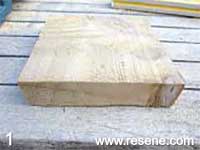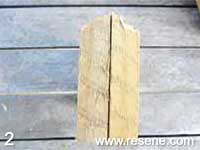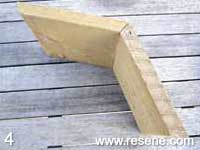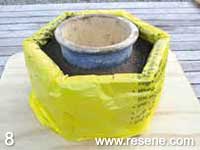You will need:
- 200 x 25mm rough sawn pine
- Screwdriver, drop saw
- 8g x 40mm screws
- Plastic bags
- Cement
- Peat moss, sand, a large bucket or bin, mixing stick
- Rubber gloves, facemask, eye protection and old clothes
Cost: $60 (excluding paint and plants).
 Step 1
Step 1
Start by making the frames. Hexagons need six sides with 60° angles at each end. Set the drop saw angle to 30°. Cut the first angle, mark 20cm, turn timber and cut second angle. Marking timber at 20cm and reversing each time, cut six pieces.
 Step 2
Step 2
Cut two more pieces with one angle cut on each, then join so that the angles form a peak and cut the two pieces to create a jig.
 Step 3
Step 3
Clamp the jig into the join between two of the hexagonal pieces.
 Step 4
Step 4
Screw through one top into the side of the next piece as shown. Do the same for the bottom of the join.
 Step 5
Step 5
Repeat this process until you have created the hexagon. Line with a large plastic bag, smoothing the bag against the sides of the frame.
 Step 6
Step 6
In a large bucket, mix the hypertufa mix. This is comprised of 2 parts peat moss, 1 part cement and 1 part sand. Always wear gloves, old clothes and eye protection when mixing cement – it can be extremely hazardous if it comes in contact with skin or eyes. Mix the three elements together with water until a firm consistency is reached – it should hold together in a ball when squeezed.
 Step 7
Step 7
Press the mix into the hexagonal mould to create a 5cm-deep base, then push a pencil or dowel through the base centre to create a drainage hole.
 Step 8
Step 8
Use a second pot to create the circular planting space, but make sure that it has a smooth surface or is well oiled so that it can be easily removed. Set aside to dry, which can take up to three days. Carefully remove the frame, brush to remove rough edges and allow to dry completely. To paint, seal with
Resene Concrete primer and then coat with
Resene Lumbersider. I used
Resene Limerick,
Resene Smitten and
Resene Gypsy Queen. Plant with your favourite potted colour!

 Step 1
Step 1 Step 5
Step 5 Step 6
Step 6 Step 7
Step 7 Step 8
Step 8![]() Get inspired ! Subscribe
Get inspired ! Subscribe ![]() Get saving ! Apply for a DIY card
Get saving ! Apply for a DIY card


